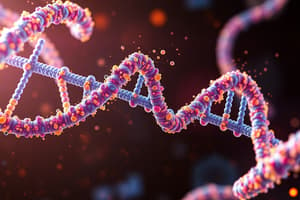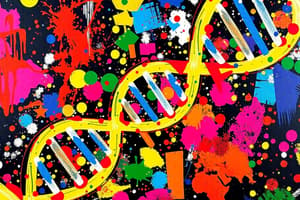Podcast
Questions and Answers
What type of bond connects adenine and thymine pairs in DNA?
What type of bond connects adenine and thymine pairs in DNA?
- Three hydrogen bonds
- Ionic bond
- Two hydrogen bonds (correct)
- Single bond
Which sugar is found in RNA?
Which sugar is found in RNA?
- Glucose
- Ribose (correct)
- Fructose
- Deoxyribose
What is the primary function of DNA?
What is the primary function of DNA?
- Stores and transmits genetic information (correct)
- Transports amino acids
- Protein synthesis
- Acts as an enzyme
Which of the following statements about RNA is true?
Which of the following statements about RNA is true?
How many hydrogen bonds connect cytosine and guanine pairs?
How many hydrogen bonds connect cytosine and guanine pairs?
Flashcards are hidden until you start studying
Study Notes
Base Pairing Rules
- Complementary Base Pairing:
- Adenine (A) pairs with Thymine (T) in DNA and Uracil (U) in RNA.
- Cytosine (C) pairs with Guanine (G) in both DNA and RNA.
- Hydrogen Bonds:
- A-T pairs are connected by two hydrogen bonds.
- C-G pairs are connected by three hydrogen bonds, making them stronger.
Nucleotide Composition
- Nucleotides:
- Consist of three components: a phosphate group, a sugar molecule, and a nitrogenous base.
- Sugar Types:
- DNA contains deoxyribose.
- RNA contains ribose.
- Nitrogenous Bases:
- DNA: Adenine, Thymine, Cytosine, Guanine.
- RNA: Adenine, Uracil, Cytosine, Guanine.
RNA Vs DNA
- Structure:
- DNA: Double-stranded helix.
- RNA: Typically single-stranded.
- Function:
- DNA: Stores and transmits genetic information.
- RNA: Plays roles in protein synthesis and gene regulation.
- Stability:
- DNA is more stable and less reactive due to the absence of a hydroxyl group on the 2' carbon.
- RNA is more reactive and prone to degradation.
Structural Functions
- DNA:
- Acts as the blueprint for genetic information, ensuring accurate replication and transmission during cell division.
- RNA:
- Messenger RNA (mRNA): Carries genetic information from DNA to ribosomes for protein synthesis.
- Transfer RNA (tRNA): Transports amino acids to ribosomes during protein synthesis.
- Ribosomal RNA (rRNA): Structural component of ribosomes, facilitating protein assembly.
Base Pairing Rules
- Adenine (A) pairs with Thymine (T) in DNA and with Uracil (U) in RNA.
- Cytosine (C) pairs with Guanine (G) in both DNA and RNA.
- A-T base pairs are linked by two hydrogen bonds, while C-G pairs are connected by three hydrogen bonds, giving C-G pairs greater stability.
Nucleotide Composition
- Nucleotides are made up of a phosphate group, a sugar molecule, and a nitrogenous base.
- The sugar in DNA is deoxyribose, while RNA contains ribose.
- Nitrogenous bases differ between DNA and RNA:
- DNA includes Adenine, Thymine, Cytosine, and Guanine.
- RNA includes Adenine, Uracil, Cytosine, and Guanine.
RNA Vs DNA
- DNA is structured as a double-stranded helix; RNA typically exists as a single strand.
- Primary function of DNA is to store and transmit genetic information; RNA is involved in protein synthesis and regulation of gene expression.
- DNA is more stable due to the lack of a hydroxyl group on the 2' carbon, making it less reactive compared to RNA, which is more prone to degradation.
Structural Functions
- DNA serves as the genetic blueprint, ensuring precise replication and transmission during cell division.
- Messenger RNA (mRNA) conveys genetic information from DNA to ribosomes for protein synthesis.
- Transfer RNA (tRNA) transports amino acids to ribosomes, facilitating the assembly of proteins.
- Ribosomal RNA (rRNA) is a key structural component of ribosomes, assisting in protein synthesis.
Studying That Suits You
Use AI to generate personalized quizzes and flashcards to suit your learning preferences.




